
(a)
Interpretation:
The mechanism and major product for the given Diels-Alder reaction is to be drawn.
Concept introduction:
The Diels–Alder reaction joins a conjugated diene and a dienophile (either an
Answer to Problem 24.44P
The mechanism and major product for the given Diels-Alder reaction is:

The
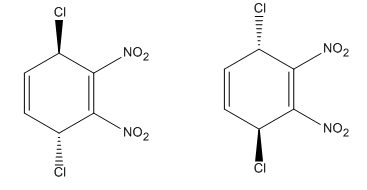
Explanation of Solution
The given reaction is:
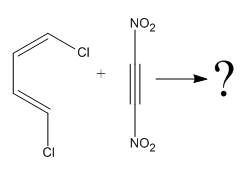
Here the diene is in trans configuration. For a Diels–Alder reaction to take place, the diene must be able to attain the

Each end carbon in the diene becomes a chiral center, noted with an asterisk. The

The mechanism and major product for the given Diels-Alder reaction is drawn from the structures of given reactants with stereochemistry.
(b)
Interpretation:
The mechanism and major product for the given Diels-Alder reaction is to be drawn.
Concept introduction:
The Diels–Alder reaction joins a conjugated diene and a dienophile (either an alkene or an alkyne) via the formation of two new
Answer to Problem 24.44P
The mechanism and major product for the given Diels-Alder reaction is:

The

Explanation of Solution
The given reaction is:
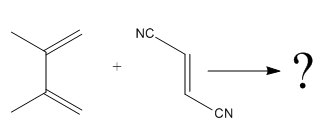
Here the cycloaddition, Diels-Alder reaction forms the six-membered ring product as:

In the above reaction, two carbons in the dienophile become chiral centers, noted with an asterisk.
The

The mechanism and major product for the given Diels-Alder reaction is drawn from the structures of given reactants with stereochemistry.
(c)
Interpretation:
The mechanism and major product for the given Diels-Alder reaction is to be drawn.
Concept introduction:
The Diels–Alder reaction joins a conjugated diene and a dienophile (either an alkene or an alkyne) via the formation of two new
Answer to Problem 24.44P
The mechanism and major product for the given Diels-Alder reaction is:

The

Explanation of Solution
The given reaction is:

Here the cycloaddition, Diels-Alder reaction forms the six-membered ring product as:

The

The mechanism and major product for the given Diels-Alder reaction is drawn from the structures of given reactants with stereochemistry.
(d)
Interpretation:
The mechanism and major product for the given Diels-Alder reaction is to be drawn.
Concept introduction:
The Diels–Alder reaction joins a conjugated diene and a dienophile (either an alkene or an alkyne) via the formation of two new
Diels–Alder reactions tend to favor an endo product over an exo product
Answer to Problem 24.44P
The mechanism and major product for the given Diels-Alder reaction is:

Diels–Alder reactions tend to favor an endo product over an exo product:
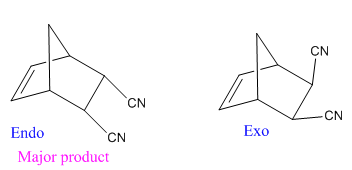
Explanation of Solution
The given reaction is:
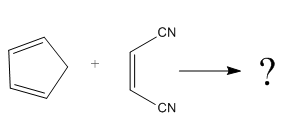
Here the cycloaddition, Diels-Alder reaction forms the bicyclic compound as product:

Here, it is noticed that two carbons of the diene and two carbons of the dienophile become chiral centers, noted with an asterisk.
The

The mechanism and major product for the given Diels-Alder reaction is drawn from the structures of given reactants with stereochemistry.
Want to see more full solutions like this?
Chapter 24 Solutions
Get Ready for Organic Chemistry
- 1. Part 1: Naming Organic Compounds он H₁C-C-CH3 CH3 Br CI CI 2. Br-CH-CH-CH₂ H₂C-CH-C= -CH-CH2-CH3 3. HC-CH-CH-C-OH 5. H₂C-CH-CH₂-OH 7. OH 4. CH CH₂-CH₂ 6. сно CH-CH-CH-CH₂-CH₂ H₁₂C-CH-CH-CH-CH₁₂-CH₁₂ 8. OHarrow_forward11 Organic Chemistry Organic Nomenclature Practice Name/Functional Group n-butane Formula Structural Formula (1) C4tt10 H3C C- (2) CH3CH2CH2 CH 3 H₂ -CH3 Н2 name & functional group (1) and (2) OH H₁₂C Н2 name only (1) and (2) name only (1) and (2) H₁C - = - CH₂ Н2 HC=C-C CH3arrow_forwardUnder aqueous basic conditions, nitriles will react to form a neutral organic intermediate 1 that has an N atom in it first, and then they will continue to react to form the final product 2: NC H₂O он- H₂O 1 2 OH Draw the missing intermediate 1 and the final product 2 in the box below. You can draw the two structures in any arrangement you like. Click and drag to start drawing a structure.arrow_forward
- Assign these COSY Spectrumarrow_forwardAssign these C-NMR and H-NMR Spectrumarrow_forwardPredict the product of this organic reaction: IZ + HO i P+H₂O Specifically, in the drawing area below draw the skeletal ("line") structure of P. If there is no reasonable possibility for P, check the No answer box under the drawing area. No Answer Click and drag to start drawing a structure. ☐ :arrow_forward
- Predict the products of this organic reaction: 0 O ----- A + KOH ? CH3-CH2-C-O-CH2-C-CH3 Specifically, in the drawing area below draw the condensed structure of the product, or products, of this reaction. (If there's more than one product, draw them in any arrangement you like, so long as they aren't touching.) If there aren't any products because this reaction won't happen, check the No reaction box under the drawing area. No reaction Click anywhere to draw the first atom of your structure. X ⑤ èarrow_forwardPredict the products of this organic reaction: O CH3 + H2O + HCI A A? CH3-CH2-C-N-CH3 Specifically, in the drawing area below draw the condensed structure of the product, or products, of this reaction. If there's more than one product, draw them in any arrangement you like, so long as they aren't touching. If there aren't any products because this reaction won't happen, check the No reaction box under the drawing area. No Reaction Click anywhere to draw the first atom of your structure.arrow_forwardWhat is the missing reactant in this organic reaction? R+ HO-C-CH2-CH3 0= CH3 CH3 —CH, C−NH—CH CH3 + H₂O Specifically, in the drawing area below draw the condensed structure of R. If there is more than one reasonable answer, you can draw any one of them. If there is no reasonable answer, check the No answer box under the drawing area. Note for advanced students: you may assume no products other than those shown above are formed. No Answer Click anywhere to draw the first atom of your structure. €arrow_forward
- 个 CHEM&131 9267 - $25 - Intro to Mail - Hutchison, Allison (Student x Aktiv Learnin https://app.aktiv.com Draw the product of the reaction shown below. Ignore inorganic byproducts. + Na2Cr2O7 Acetone, H2SO4 Type here to search Dryng OH W Prarrow_forwardPredict the products of this organic reaction: OH + NaOH A? Specifically, in the drawing area below draw the skeletal ("line") structure of the product, or products, of this reaction. (If there's more than one product, draw them in any arrangement you like, so long as they aren't touching.) If there aren't any products because this reaction won't happen, check the No reaction box under the drawing area. No reaction Click and drag to start drawing a structure. ✓ Sarrow_forwardPredict the products of this organic reaction: CH3-C-O-CH2-CH2-C-CH3 + H₂O ? A Specifically, in the drawing area below draw the condensed structure of the product, or products, of this reaction. (If there's more than one product, draw them in any arrangement you like, so long as they aren't touching.) If there aren't any products because this reaction won't happen, check the No reaction box under the drawing area. No reaction Click anywhere to draw the first atom of your structure. :☐ darrow_forward
 ChemistryChemistryISBN:9781305957404Author:Steven S. Zumdahl, Susan A. Zumdahl, Donald J. DeCostePublisher:Cengage Learning
ChemistryChemistryISBN:9781305957404Author:Steven S. Zumdahl, Susan A. Zumdahl, Donald J. DeCostePublisher:Cengage Learning ChemistryChemistryISBN:9781259911156Author:Raymond Chang Dr., Jason Overby ProfessorPublisher:McGraw-Hill Education
ChemistryChemistryISBN:9781259911156Author:Raymond Chang Dr., Jason Overby ProfessorPublisher:McGraw-Hill Education Principles of Instrumental AnalysisChemistryISBN:9781305577213Author:Douglas A. Skoog, F. James Holler, Stanley R. CrouchPublisher:Cengage Learning
Principles of Instrumental AnalysisChemistryISBN:9781305577213Author:Douglas A. Skoog, F. James Holler, Stanley R. CrouchPublisher:Cengage Learning Organic ChemistryChemistryISBN:9780078021558Author:Janice Gorzynski Smith Dr.Publisher:McGraw-Hill Education
Organic ChemistryChemistryISBN:9780078021558Author:Janice Gorzynski Smith Dr.Publisher:McGraw-Hill Education Chemistry: Principles and ReactionsChemistryISBN:9781305079373Author:William L. Masterton, Cecile N. HurleyPublisher:Cengage Learning
Chemistry: Principles and ReactionsChemistryISBN:9781305079373Author:William L. Masterton, Cecile N. HurleyPublisher:Cengage Learning Elementary Principles of Chemical Processes, Bind...ChemistryISBN:9781118431221Author:Richard M. Felder, Ronald W. Rousseau, Lisa G. BullardPublisher:WILEY
Elementary Principles of Chemical Processes, Bind...ChemistryISBN:9781118431221Author:Richard M. Felder, Ronald W. Rousseau, Lisa G. BullardPublisher:WILEY





